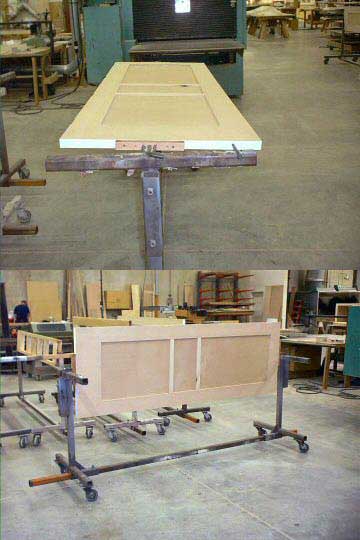Issues with On-Site Spraying
Applying clear finishes on site comes with complications. Are water-based finishes preferable to conversion varnish? Finishers exchange views. August 30, 2005
Question
The people at my ML Campbell distributor advise me not to spray Duravar (PostCat lacquer) onsite at a high-end new construction home. It is on the third floor of a commercial building. I have 17 8-foot cherry doors and casings to stain and seal. I want the amber antique look that Duravar provides. I have used Magnamax, but need something special. Does anyone have any suggestions?
Forum Responses
(Finishing Forum)
From contributor B:
Sure you can – it’s just like any other solvent based material. Just make sure you have plenty of ventilation, masking.
From contributor Y:
In my opinion I would worry more about myself or whoever will be doing the finishing. A few years ago I made the mistake of forgetting to put on my mask while coating a piece I was spraying with Duravar. Never again will that happen and that was in a very well ventilated spray booth. If you work with it a lot you know it's like respiratory failure in a can. I would probably think that in an on-site situation it would be a little more difficult to adequately ventilate unless you have a very low over-spray system.
From contributor M:
Why is Duravar any more special then Magnamax?
From contributor B:
Of course you can spray Duravar in-site. It handles no differently and no less dangerously than ordinary lacquer. By the same token it is no more dangerous than ordinary lacquer when used in an onsite application setting. If you have a procedure down for onsite spraying then go ahead with Duravar. If you have little experience with onsite spraying then any solvent coating is one you want to be careful about laying down with a spray gun. In addition to masking and papering, remember to tape off the electrical outlets.
From contributor M:
Just a thought here, you didn't say what area of the country you are in and there are parts of the country where spraying onsite can be illegal. Do you have a shop where you could finish the doors in a booth? I prefer to do doors in a controlled environment anyway if possible and I have door carts that allow me to spray both sides of the door flat at the same time. If you can't spray them in shop perhaps there is a garage or basement area that could be converted into a spray area?

From contributor T:
I use almost exclusively ML Campbell products. Duravar, Krystal Resistant, and even Magna max. In my own search for a less volatile finish I found that Van Technologies water based 0r 482 has almost the same amber coloring as Duravar and near the same dry time and actually is as hard as the post-cats. I really like it and would be a non-issue for site work.
From contributor M:
Also, just because a product is water-based, that doesn’t make it safe to spray onsite. Get an MSDS sheet and read it. A lot of water-based products are just as hazardous, or more so to health as solvent based products.
From contributor A:
Contributor M. WB is safer due to it not being flammable. However it is not necessarily safe. It still contains solvents and resins and other goodies in there. Always follow all safety precautions on your MSDS.
From the original questioner:
To contributor T: Your statement on wanting the Amber finish that Duravar provides is in fact what I am trying to achieve on this cherry project. Magnamax just does not get that tone. I would love to change to a less volatile coating system. Rub-on oil finish would be the best, but the project could take months to achieve the desired quality and finish my client deserves.
From contributor T:
While Duravar does not present any more of a fire hazard than a regular nitrocellulose lacquer it does give off formaldehyde. This off gassing will go on for a period of time after the fire hazard is no longer present so the extraction of air will have to continue much longer than with nitrocellulose.
From contributor D:
If you want to give a durable coating that is easy to use, Duravar is one good choice. There are always tradeoffs and liabilities in any choice. If you want to lay down a truly 100% safe finish, then coat your projects with ice. But the finish will not last. That is the extreme, obviously, but I suggest it to make a point.
Back to Duravar; even if you finish in the shop, it is still off gassing by the time you do your delivery and installation. The presence of formaldehyde has little to do with the issue of spraying onsite. The most important issue of spraying onsite is the fire hazards created (or not).
The advanatge of Duravar or any catalyzed lacquer or any conversion varnish is that in two days time after application you have a coating which has undergone 85% of its cross linking. Waterbase coatings are not at full durability until a few weeks later after application.
Know the parameters of your materials and know the requirements you need to apply them safely and properly. Then, make your decisions. Prioritize the issues according to a hierarchy that makes the most sense for you and take into account all the risks. Do what you need to do to avoid nasty consequences of accidents (that means that safety comes first).
Onsite spraying with solvent materials requires a lot of prep. Ground your containers and mask off your wall outlets. You are turning your onsite location into a finish room. That's a lot of doing. Do not forget to take into account spill prevention. I use a laboratory type tray but a fiberglass shower stall (the bottom) is enough for where you want to pour your materials and mix them.
